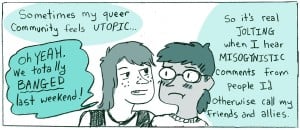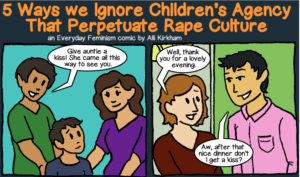
A farmer stands confidently inside a greenhouse, arms crossed and expression certain.
There’s a common misconception that all environmental work being done to combat climate change is the same and working towards the same goal.
But when we take a bit more time to understand these efforts with more depth, it becomes clear pretty quickly how different the priorities of some environmental work are from others.
Mainstream environmentalism is the perspective we hear about the most in mainstream media, from our government officials, and within a large portion of environmental non-profits and organizations.
This type of environmental work often lacks the type of action that needs to be taken to combat climate change from a social justice perspective and in ways our planet actually needs. We can see this in the different narratives used by the mainstream environmentalist movement the vast majority of the time.
Aside from telling stories and sharing experiences in a way that unites and builds, narratives are used to define problems, set goals, reach decisions, and prioritize work. Governments, organizations, and corporations who generally identify with mainstream environmentalism try to justify their actions (or inaction) regarding our environment by using these narratives to tell the story of climate change.
The problem with these narratives is that they almost always only inclusive of the needs, perspectives, and experiences of those least affected by climate change.
This way of addressing climate change delays the type of environmental action we need our governments and industries to be taking to provide the resources and attention necessary – and to prevent further harm caused by previous and current actions of colonizers, exploiters, capitalists, consumers, and developers.
The actions we need to be taking prioritize the safety of those most impacted, highlighting their experiences and needs not only to survive, but also to maintain cultural stability and growth.
When these perspectives are silenced or neglected the way they are in the mainstream environmentalist movement, little more occurs than the perpetuation of current oppressive systems we collectively live under – such as capitalism, racism, and colonialism.
The mainstream environmentalist movement too often places the comfort of those with the most resources, greatest political influence, and whitest skin over the needs of those most impacted – most often, low-income communities and communities of color in different areas of the world.
This is how mainstream environmentalism almost always takes action with an end goal to sustain systems rather than change them – no matter how harmful and exploitative they are.
These actions to “green our planet” are often taken with the intention of adjusting only what is seen as necessary to continue running our planet with the same colonial, profit-hungry mentalities it has maintained for centuries.
To continue addressing environmental issues and concerns the way we have been would be to leave behind millions of people fighting a struggle intertwined with our own. Neglecting the needs of these communities and populations builds the foundation for a movement and a feminism that is only for the most privileged.
I don’t see us achieving the goals of a liberating feminist movement without including these missing voices, because I don’t believe we will achieve liberation until it has been reached for everyone.
Following is a list of five narratives mainstream environmentalism use to perpetuate oppressive systems.
1. Save the Polar Bears, Save the Profits
The mainstream environmentalist movement often prioritizes the maintenance of an economic system that has sustained itself on the exploited labor of people in marginalized communities.
It also frequently prioritizes the protection of cute animals that are appealing to a wide public audience while neglecting the struggles of communities and entire human populations fighting against the effects of climate change to survive.
In this way, much environmentalism works to save the profits and save the polar bears, but does little to advocate for people most affected.
We hear that in the future, when our oil and water supplies have all but dried up, our economies will crash terribly, lacking in resources it’s entirely dependent on. Additionally, this narrative also often argues that we need to save poor communities most damaged by these environmental effects not because they are inherently valuable as people, but because their labor is necessary for our economies to continue working.
We’re told that our only chance at achieving any future economic “stability” is not by changing how we value the work and the lives of those in our societies, but by our energy sources – when what we really need is both.
The reasons behind going green cannot be grounded in profit-hunger if we want to build communities and economies in the future that are actually sustainable and beneficial to the many, rather than the few.
Mainstream environmentalism devalues the lives of communities through this “economic” perspective, and also through the way it discusses our need to protect animals. It’s historically been easier to find funding for work that saves the cute animals we like than it is to fund work for communities holding the majority of the resources feel detached from and are taught not to relate to.
Don’t get me wrong. I’m all for supporting and protecting animal lives and their habitats, but not when it results in millions of dollars in donations and grants being awarded to organizations fighting to save a few polar bears over the prevention of entire populations being displaced from natural disasters caused by climate change.
2. The Future Is Bleak; The Present Is Fine
This narrative defines climate change as a future problem, rather than one that’s already affecting our world. Of course, climate change will be a problem in the future and will only get worse with time if continued to be neglected, but this perspective ignores hundreds of populations already experiencing destructive effects from climate change.
When we take on this mindset, we perpetuate colonialism, which has only ever seen colonizing populations (and the problems that affect them) as valid, important, and worthy of their attention.
It allows privileged folks (whether they be countries, neighborhoods, communities, or families) to only take responsibility for what affects their own communities – giving them the ability to ignore everyone else.
A solid example of this is when we hear that water accessibility will only be a problem in years to come. This again only tells a story from the perspective of the rich and privileged, silencing others.
While water accessibility has yet to become an issue for some, it has long been an issue for many. Ignoring these experiences leads to situations like the 23,300 homes in Detroit who had their water shut off just last year or the entire population of Flint, Michigan having their water poisoned. Meanwhile, companies like Nestlé are given opportunities to be approved by the Michigan Department of Environmental Equality to increase the amount of fresh water they steal from our Great Lakes.
When each of us is only focusing on what impacts us and our communities directly, it’s difficult to build a coherent movement. We’re all affected by different issues, and we all have different privileges and vulnerabilities.
If our goal is to build a social base strong enough to create the change we want to create, we need to be listening to the needs of the many and of the few. We need to acknowledge the different layers in which these needs and priorities exist based on identities and access to resources.
3. We Don’t Have the Money for Everything That’s Needed
This argument is frequently used by members of the US government and says that there just isn’t enough money in the budget to further fund protection and prevention against climate-related disasters. Period.
But I have a really hard time believing this, especially when the United States spends 28 times the amount of funding on its military than it does on climate and environmental security measures.
To our government, a disaster is not only far more worthy to be addressed and relief provided if it’s considered a problem of the military, rather than a problem “created by nature.” As a reminder, these military funds and resources are the same ones being shared with police departments.
This includes the North Dakota Police Department, which has made the choice to align themselves with Dakota Access Pipeline (DAPL) supporters and by threatening, intimidating, silencing, and committing acts of violence against the water protectors of the Standing Rock Sioux Tribe resisting the implementation of the DAPL through their native land.
When this argument is used, it’s not to say that we don’t have money. It’s to say that we don’t have money to defend certain people, but we do have money to harm them.
It’s saying that we don’t have money to prevent climate-related disasters through proactive motions, but we do have the money to prevent political and military-related disasters through fear.
It’s to say that we don’t have time for justice, we have time for intimidation.
4. Green Development Is Good Development
We often hear and read stories about new “green” projects being implemented in neighborhoods, especially when those neighborhoods are ones that have previously been neglected by institutions created to support them – and are low-income or largely populated by people of color.
We’re told that city and state governments work on these projects with developers and investors to bring green infrastructure into neighborhoods and “turn things around.”
But what isn’t said here is that many of the long-standing residents of these areas being “newly developed” aren’t even asked what they think of these new changes.
The needs of these communities aren’t taken into account largely because these “development plans” aren’t usually to create green areas for those residents – they’re for new residents who they hope to bring in. And they can only do that while pushing long-standing residents out through increased taxes, buying out small businesses, and building new infrastructure.
This new infrastructure is often called “green” and “environmentally friendly” without answering the question: Environmentally friendly for whom?
When the implementation of green infrastructure plays a role in gentrification, it’s not for the benefit of those who need the most support. It instead pushes folks out of their homes and often into other communities with more environmental hazards.
5. We All Need to Do Our Part
This narrative maintains that everyone is equally responsible for the destructive acts committed towards our planet, and that everyone needs to do the same amount of work to get us out of this mess.
It does not take into account who is most affected, who has lost the most, who has and continues to contribute the highest rates of pollution, or who is already struggling due to other forms of oppression.
There’s no attention paid to who should be held most accountable, who has the most to give, and who deserves the most support based on need and histories of oppression.
This liberal mentality ignores the inequalities centuries of oppression has created, and puts the need for labor onto everyone equally when some have benefitted from the polluting of this planet while many have disproportionately suffered because of it.
These arguments don’t fall in line with what it would look like if everyone did do what their part actually is, including the factors previously mentioned. Most often, the brunt of the work, and even the funding for that work, comes out of the pockets and from the hands of those most negatively affected.
In this way, this narrative just becomes another way for institutions to exploit the unpaid labor of those most underprivileged by increasing taxes and penalties regarding environmentally friendly infrastructure.
In addition to being exploitative and oppressive, it’s often largely ineffective, as it tends lean on the idea that if each individual resident just did our part to turn the lights off when we’re not using them, use as few resources as possible, recycle, carpool, and educate ourselves on climate issues, we wouldn’t be dealing with climate change.
While I’m a supporter of small acts, using them to build this narrative diverts attention away from monsters in energy and mining industries who need to be held accountable by our governments if we’re actually going to achieve the change that’s needed.
So What Can We Do Instead?
Contrary to popular belief, there is actually more than one environmental movement fighting hard against climate change. One of these other movements is the environmental justice movement.
Environmental justice differs from mainstream environmentalism by how it interacts with local communities and how it prioritizes needs for change. Because environmental justice is built from a social justice core, it easily aligns itself with other social justice movements and values.
Though environmental justice work is significantly more important and necessary from a social justice perspective, like most other important work happening today, it is largely undervalued, neglected by funders, and frequently ignored by many large media outlets.
Despite all of this, environmental justice work can be found all around the US and the rest of the world.
In the United States, the environmental justice movement is embodied by the Sioux Nation water protectors demanding the cancelation of the implementation of the Dakota Access Pipeline; by clean air activists in Detroit, Michigan working to educate themselves and each other and shut down an incinerator that poisons the air for a large percentage of Detroit’s residents daily; and students standing up to their universities insisting for divestment from companies that mine fossil fuels.
In other parts of the world, activists in India stand up against corporations forcibly ruining their soil and lands to reach the coal that sits underneath, while organizers in Honduras continue their fight for environmental justice despite the recent assassination of environmental activist Berta Cáceres, who resisted a huge hydroelectric project set in space held sacred by the indigenous Lenca population.
I’m not arguing that some of the measures taken by mainstream environmentalists shouldn’t be taken. What I’m arguing for is a serious reprioritization of values and efforts in the majority of well-funded, highly visible, and institutionally supported environmental work.
When communities of color around the world are being washed away and destroyed by hurricanes and floods, while others suffer from heat exhaustion or lack of resources, and still others are experiencing their land being stolen in the name of development, we can’t say we’re addressing climate change.
We can’t say that we’re addressing climate change by increasing our percentage of recycling each month, investing in solar-powered parking meters, or taking action based on narratives discussed here.
Environmental justice has the most potential to accomplish what mainstream environmentalism cannot, which is safe and clean homes, jobs, families, and resources for everyone, while respecting communities’ historical and cultural needs.
[do_widget id=’text-101′]
Aiko Fukuchi is a queer organizer, writer, and intersectional feminist. After completing a degree in Anthropology at the University of Michigan, they moved to Detroit to organize around issues including queer/trans liberation, sexual assault advocacy, and environmental justice. Aiko also enjoys reading books by their favorite authors (B. Yoshimoto, W. Shire, and U. LeGuin, to name a few), hanging out with their cat (Franklin), and bartending.
Search our 3000+ articles!
Read our articles about:
Our online racial justice training
Used by hundreds of universities, non-profits, and businesses.
Click to learn more




















